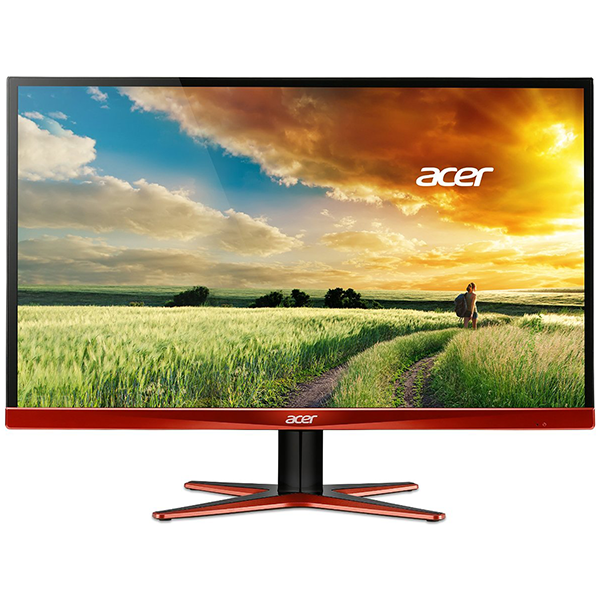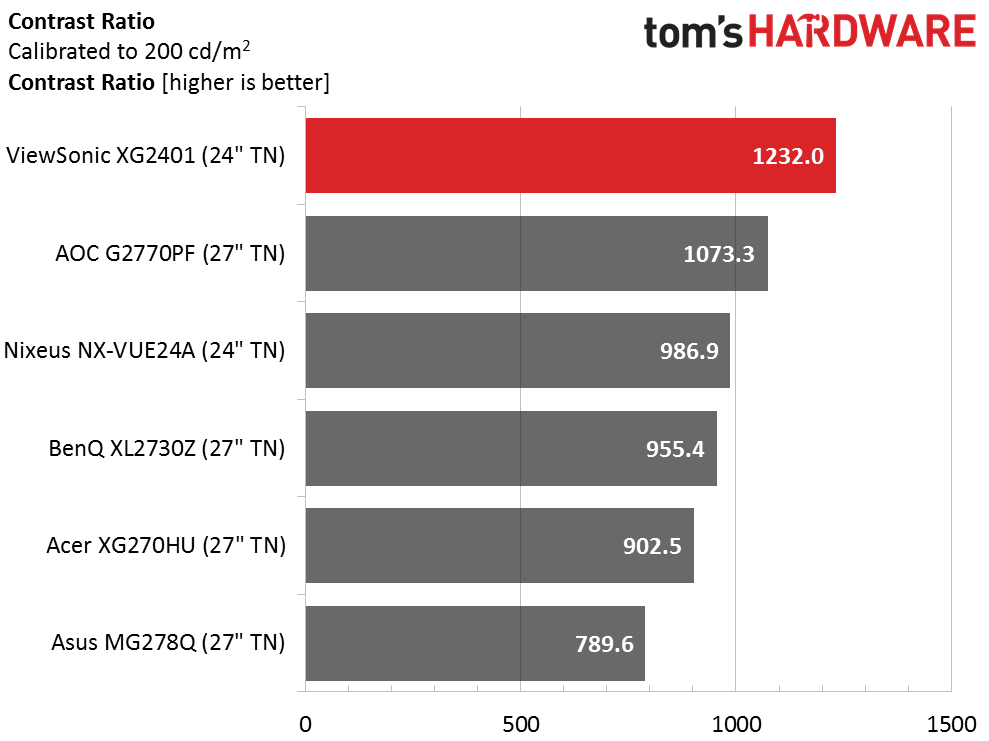ViewSonic XG2401 24-inch FreeSync Monitor Review
ViewSonic is the latest major display manufacturer to add FreeSync to its lineup. Today, we're testing the 24-inch XG2401. It's a FHD/TN screen with a 144Hz refresh rate and ultra-fast panel response.
Why you can trust Tom's Hardware
Brightness And Contrast
To read about our monitor tests in-depth, please check out Display Testing Explained: How We Test Monitors and TVs. Brightness and Contrast testing is covered on page two.
Uncalibrated – Maximum Backlight Level
FreeSync is the least expensive way to add adaptive refresh to your gaming rig. To that end we've collected data from five other TN-based monitors that sell in the $275 to $500 range. The Asus MG278Q, Acer XG270HU and BenQ XL2730Z are QHD while the XG2401, Nixeus NX-VUE24A and AOC G2770PF are FHD. The higher pixel count typically adds about $200 to the price.
The XG2401 has light output to spare with brightness over 400cd/m2. While most of us would burn our retinas at this level indoors, it's helpful when you have to compete with incoming sunlight.
The max black level only drops to third place, which means this monitor has pretty high contrast compared to other TN and IPS panels.
This is one of the highest contrast results we've measured from a non-VA screen. We realize the product's main draw is its 144Hz refresh rate and FreeSync operation. But image depth is still important and the XG2401 has plenty of that.
Uncalibrated – Minimum Backlight Level
The backlight goes a little low for our taste. Raising the slider to four will give you a more palatable 50cd/m2.
The Nixeus wins this contest thanks to its super-low backlight setting. The ViewSonic's black levels continue to impress, however, with a second-place finish.
Get Tom's Hardware's best news and in-depth reviews, straight to your inbox.
Minimum contrast remains above 1200:1, which is excellent performance. TN may not be everyone's favorite technology but the latest panels offer great image quality and the XG's 24-inch size mitigates most of our viewing angle concerns.
After Calibration to 200cd/m2
After calibration, we see an even lower black level than before. It helps that we are able to increase the contrast slider; something we almost never do. And full detail is retained at both the shadow and highlight ends of the scale.
The final calibrated contrast result is one of the best we've recorded from a TN or IPS display. When viewed straight-on, you won't be able to tell which technology is in use. ViewSonic's choice of TN has kept speeds high and the price reasonable without any sacrifices in image fidelity.
ANSI Contrast Ratio
Thanks to some of the best panel uniformity we've seen lately, the XG2401 lays down an impressive ANSI test result. Very few panels of any type can match their sequential numbers so closely. The part in use here is obviously of high quality.
Current page: Brightness And Contrast
Prev Page OSD Setup And Calibration Next Page Grayscale Tracking And Gamma Response
Christian Eberle is a Contributing Editor for Tom's Hardware US. He's a veteran reviewer of A/V equipment, specializing in monitors. Christian began his obsession with tech when he built his first PC in 1991, a 286 running DOS 3.0 at a blazing 12MHz. In 2006, he undertook training from the Imaging Science Foundation in video calibration and testing and thus started a passion for precise imaging that persists to this day. He is also a professional musician with a degree from the New England Conservatory as a classical bassoonist which he used to good effect as a performer with the West Point Army Band from 1987 to 2013. He enjoys watching movies and listening to high-end audio in his custom-built home theater and can be seen riding trails near his home on a race-ready ICE VTX recumbent trike. Christian enjoys the endless summer in Florida where he lives with his wife and Chihuahua and plays with orchestras around the state.
-
darthtomas_admin 1st lol. On the serious note, is the panel native 8-bit one? That contrast ratio looks too good to be true .....Reply -
eklipz330 48hz isn't optimal but it sure as hell is still damn good. 20hz would be perfect.Reply
freesync is kicking ASS. i hope nvidia continues to rest on their laurels as AMD picks up more market share and becomes a more formidable competitor. -
karloe CONS: 48Hz lower FreeSync --> Christian, didn't you hear about Low Framerate Compensation?Reply
144 > 2,5x48 --> meaning LFC is on so the actual FreeSync range is 0-144Hz -
ubercake Great contrast. Definitely a plus for gaming. If you have the goods to keep framerates above 48 consistently, this monitor looks like a catch.Reply -
darthtomas_admin Christian, could you confirm screen part number ( is it real 8-bit one or 6-bit+dithering ) please.Reply -
sillynilly Another low price monitor good for a low range gaming rig. Not my cup of tea, but cool that the market isn't abandoning the cheaper options for peeps that don't run the latest, greatest parts in their rigs.Reply -
slashdot Not sure why people diss the "low price monitor", but Freesync and Gsync needs to encompass a larger range of price point. Faster value adoption means paying less "premium" for Freesync/Gsnyc in the top range. Otherwise, adaptive sync would be niche tech that would die in a year and two, and the so-called "premium feature" would no longer be supported.Reply











